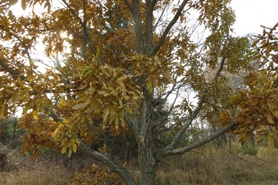Sawtooth oak
(Quercus acutissima)
Fast-growing deciduous tree up to 50 feet tall. Pyramidal in shape when young but becomes more rounded when mature. Gray-brown bark becomes deeply furrowed. Twigs are slender and red to gray-brown with triangular buds and slightly hairy scale edges.
Classification in Wisconsin: Prohibited
- Ecological Threat
-
- It is commonly encouraged for planting as wildlife forage and habitat due to the mass production of acorns after a short period.
- Escapes from urban settings into nearby natural areas, including forests.
- It is tolerant of many types of soil and growing conditions.
- It can hybridize with native oak species.
- Identification
-
Leaves: Simple, alternate and shiny two to eight inches long. Leaves are dark green that turns dull yellow or brown in fall. Leaf edges are serrated and bristled.
Flowers: Brown, inconspicuous and monoecious.
Fruits & seeds: Brown, oval acorns with a cap with long recurving scales covering most of the nut.
Similar species: Chestnut (Castanea spp.) has identical leaves that are larger.
- Control
-
Mechanical: Pull seedlings.
Chemical: Foliar sprayed small trees with glyphosate. For more giant trees, girdle and spray with glyphosate or use it as a cut stump treatment.
- Resources
- Sources for content:
- Czarapata, Elizabeth; Invasive Plants of the Upper Midwest: an illustrated guide to their identification and control. The University of Wisconsin Press. 2005. Pg. 125



